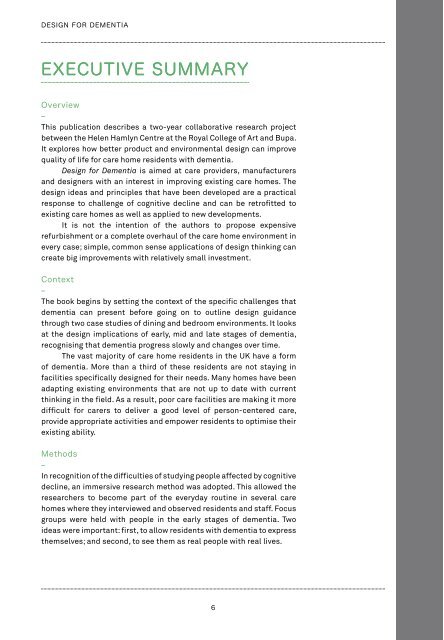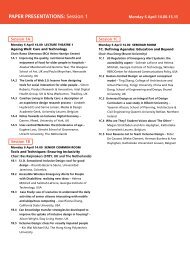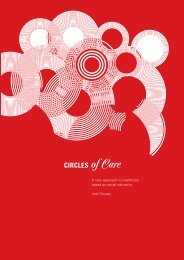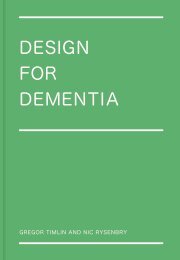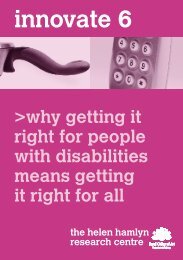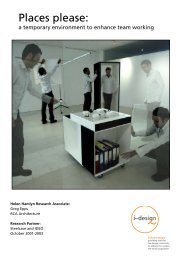Design for Dementia - Helen Hamlyn Centre - Royal College of Art
Design for Dementia - Helen Hamlyn Centre - Royal College of Art
Design for Dementia - Helen Hamlyn Centre - Royal College of Art
Create successful ePaper yourself
Turn your PDF publications into a flip-book with our unique Google optimized e-Paper software.
DESIGN FOR DEMENTIA<br />
EXECUTIVE SUMMARY<br />
EXECUTIVE SUMMARY<br />
Overview<br />
–<br />
This publication describes a two-year collaborative research project<br />
between the <strong>Helen</strong> <strong>Hamlyn</strong> <strong>Centre</strong> at the <strong>Royal</strong> <strong>College</strong> <strong>of</strong> <strong>Art</strong> and Bupa.<br />
It explores how better product and environmental design can improve<br />
quality <strong>of</strong> life <strong>for</strong> care home residents with dementia.<br />
<strong>Design</strong> <strong>for</strong> <strong>Dementia</strong> is aimed at care providers, manufacturers<br />
and designers with an interest in improving existing care homes. The<br />
design ideas and principles that have been developed are a practical<br />
response to challenge <strong>of</strong> cognitive decline and can be retr<strong>of</strong>itted to<br />
existing care homes as well as applied to new developments.<br />
It is not the intention <strong>of</strong> the authors to propose expensive<br />
refurbishment or a complete overhaul <strong>of</strong> the care home environment in<br />
every case; simple, common sense applications <strong>of</strong> design thinking can<br />
create big improvements with relatively small investment.<br />
Context<br />
–<br />
The book begins by setting the context <strong>of</strong> the specific challenges that<br />
dementia can present be<strong>for</strong>e going on to outline design guidance<br />
through two case studies <strong>of</strong> dining and bedroom environments. It looks<br />
at the design implications <strong>of</strong> early, mid and late stages <strong>of</strong> dementia,<br />
recognising that dementia progress slowly and changes over time.<br />
The vast majority <strong>of</strong> care home residents in the UK have a <strong>for</strong>m<br />
<strong>of</strong> dementia. More than a third <strong>of</strong> these residents are not staying in<br />
facilities specifically designed <strong>for</strong> their needs. Many homes have been<br />
adapting existing environments that are not up to date with current<br />
thinking in the field. As a result, poor care facilities are making it more<br />
difficult <strong>for</strong> carers to deliver a good level <strong>of</strong> person-centered care,<br />
provide appropriate activities and empower residents to optimise their<br />
existing ability.<br />
Methods<br />
–<br />
In recognition <strong>of</strong> the difficulties <strong>of</strong> studying people affected by cognitive<br />
decline, an immersive research method was adopted. This allowed the<br />
researchers to become part <strong>of</strong> the everyday routine in several care<br />
homes where they interviewed and observed residents and staff. Focus<br />
groups were held with people in the early stages <strong>of</strong> dementia. Two<br />
ideas were important: first, to allow residents with dementia to express<br />
themselves; and second, to see them as real people with real lives.<br />
<strong>Design</strong> Strategy<br />
–<br />
A design strategy was developed to create proposals <strong>for</strong> facilities and products<br />
which enhance residents’ abilities in three key areas:<br />
Cognitive Ability is improved by promoting the use <strong>of</strong> familiar and recognisable<br />
surroundings and activities that respond to residents’ deepest and<br />
earliest memories.<br />
Social Ability is addressed through the design <strong>of</strong> artefacts and amenities<br />
that create opportunities <strong>for</strong> residents and staff to interact more easily in<br />
activities <strong>of</strong> daily living.<br />
Physical Ability is promoted through design which unobtrusively compensates<br />
<strong>for</strong> disabilities such as mobility and vision which are prevalent among<br />
care home residents.<br />
These values have been exemplified in two case studies that explore concepts<br />
and prototypes <strong>for</strong> dining areas and Bedrooms.<br />
Dining<br />
–<br />
The dining section explores how to improve dining culture and rituals without<br />
changing existing food service infrastructure. The following practical design<br />
changes are proposed:<br />
Interior layouts that reduce visual and physical barriers <strong>for</strong> residents, allowing<br />
<strong>for</strong> more safe and unrestricted movement throughout dining areas and the<br />
care home.<br />
<strong>Design</strong> <strong>of</strong> amenities which capitalise on redundant space and integrate<br />
activities such as cooking and gardening into existing spaces.<br />
New lighting and furniture design which allow <strong>for</strong> greater physical access <strong>for</strong><br />
those with poor visual acuity and mobility problems, including a wheelchair<br />
accessible table and dimmable overhead light.<br />
New tableware designed to promote independent eating and improve the<br />
experience <strong>of</strong> being fed <strong>for</strong> those who are no longer able to feed themselves.<br />
6<br />
7


